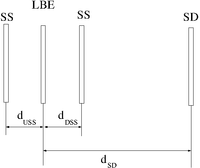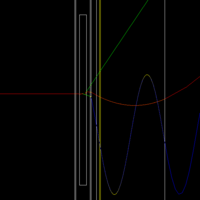Niowave 2-2016
Niowave Positron Project Progress for February 2016
Event files were generated for Niowave's beam line designers assuming an ideal solenoid having an inner radius of 2.527 cm surrounding a beam pipe with a radius of 1.74 cm. Electrons impinge a 2mm thick PbBi liquid target that has a surface area of 2.54 cm x 2.54 cm. Stainless steel windows 0.25 mm thick sandwhich the PbBi target at locations Z= -90.325 and Z= -89.875 cm. The target is located at Z =-90.1 cm and the beam begins 20 cm upstream at Z = -110.1 cm. The incident electron beam is a 0.5 cm radius cylinder.
Below is a table illustrating the target and stainless steel window geometry as well as a rare event where positrons were produced in the stainless steel window instead of the PbBi target. The solenoid design uses a maximum uniform field of 0.20 Tesla and a length of 150 mm. Twenty (20) million incident electrons with an energy of 10 MeV and forming a cylindrical beam with a 0.5 cm radius cylinder impinged a 2mm thick LBE target located at Z = -106 mm. The Z location of positrons exiting the beam pipe at the end of the 15 cm long solenoid is 44 mm. The positrons are 150.00 mm from the middle of the LBE target (Z=44mm). A space delimited text file with the above events in the format of
PID, x(mm),y,z,Px,Py,Pz(MeV),t(ns)
in units of cm for distance and MeV for momentum was delivered to Niowave

